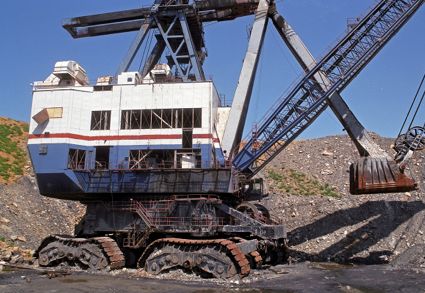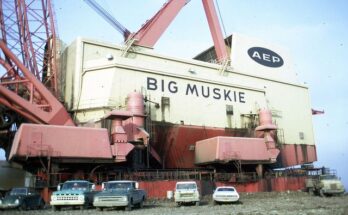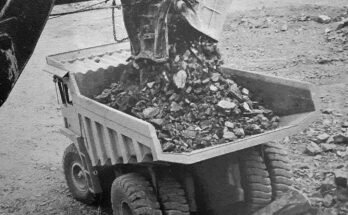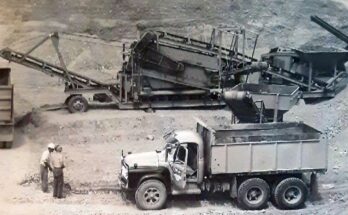
On a warm summer evening 30 years ago, a catastrophic fire wiped out the largest shovel ever built, leaving an indelible mark on all who were involved in the event. The Marion 6360 stripping shovel, known as “the Captain,” was the centerpiece of the vast Captain mine complex near Cutler, Illinois. When it was first deployed in 1965 by Southwestern Illinois Coal Corp., the shovel captured global attention for its size and engineering.
At an immense 180 yd³ capacity, the Captain wielded the largest dipper ever mounted on a shovel. Its two dipper doors, each weighing 15 tons, added to its colossal presence. (Photo: Keith Haddock)
A marvel of American engineering, the Captain was commissioned on October 15, 1965, and named after Thomas C. Mullins, known as Captain Mullins, a pioneer in surface coal mining technology. His son, W.E. (Bill) Mullins, who was the president of Southwestern, named both the machine and the mine in honor of his father. Although $25 million in 1965 might not sound like much today, that was the cost of the Captain shovel—equivalent to the price of Caesars Palace, which also opened that year. Southwestern was acquired by Arch Mineral Corp. in 1969, which later became Arch Coal.
The shovel’s size and specifications are nearly impossible to grasp. Weighing an estimated 15,000 tons, it was more than twice the weight of the Silver Spade, the previous largest operating stripping shovel, which weighed 7,200 tons. The Captain’s 215-foot boom towered more than 200 feet above the ground, with an undercarriage width of 88 feet and a maximum dumping height of 153 feet. Its 18-foot-wide dipper could hold 180 yd³ or 300 tons of rock and earth and was the only shovel ever built with two dipper doors. Each of these doors weighed 15 tons.
Mounted on eight crawler units, each 45 feet long and 16 feet high, the Captain’s frame was supported by massive vertical hydraulic cylinders, each standing nearly 17 feet high. The machine’s electrical system was equally formidable, with a total of 16 motors powering the machine: eight hoist motors rated at 16,000 hp, eight swing motors at 10,000 hp, four crowd motors at 4,000 hp, and 16 propel motors totaling 3,200 hp. With all these motors running simultaneously, the Captain consumed enough electricity to power a town of 30,000 people.
On the evening of September 9, 1991, Gene Miller was operating the Captain during the afternoon shift, which ran from 4 p.m. to midnight. Around 7 p.m., Miller noticed a burning smell and stopped the machine, accompanied by oiler Fred Kruger. “That kind of smell could come from many sources,” Miller recalled. “It could have been a brake shoe sticking, an overheated bearing, or an electrical fault.” After checking the machine’s house, they noticed smoke rising from the lower works, where they discovered that hydraulic oil had ignited.
Miller, Kruger, and welder Gary Andrews immediately began fighting the fire with 20-pound dry chemical extinguishers. These extinguishers were positioned around the machine, but as the fire grew rapidly, they quickly ran out. Realizing the need for additional support, Miller reported the fire to the mine office, while Andrews ascended to the roof to retrieve more extinguishers.
The mine’s two small fire trucks, which carried 200-pound dry chemical extinguishers, proved ineffective. The fire had spread to a height of about 30 feet, making it impossible to access the blaze. The smoke and flames were so intense that it was deemed unsafe to approach. By 9:44 p.m., the mine office called for assistance from the Cutler Fire Protection District. Fire Chief Larry Bennett responded, calling in additional support from nearby fire brigades. By the end of the night, fire departments from Pinckneyville, Percy, Campbell Hill, Steeleville, Coulterville, DuQuoin, and Sparta had all joined the battle to contain the fire.

The fire on the night of September 9, 1991, that destroyed the Captain. The firefighting vehicles in the foreground are on a bench some 25 ft above the pit floor on which the shovel is standing. (Photo with special permission, Copyright 1992, J. Monroe)
Welder Gary Andrews continued his account, saying, “I made three trips up the elevator to the roof to bring down fire extinguishers. By the third time, the smoke had turned thick and black, filling the house completely. It was so dense I couldn’t see anything, and soon, smoke began pouring up the elevator shaft, making it impossible for me to go back down. By then, the other crew members had descended to the ground using ladders. I did everything I could to save the machine, but it became clear that I was trapped. I waited on the roof to see if the rough terrain crane with a man basket could reach me, but it couldn’t. The heat from the fire became unbearable, and I had to climb to the very top of the gantry to escape.”
Miller added to the story, “By now, it was completely dark, and Gary was stuck on the roof. The electrical system had shut down, which was a lucky break because it happened after he had left the electrically powered elevator. He couldn’t reach the ground through the ladders or even re-enter the house due to the extreme heat and smoke. The situation was dangerous—there was a lot of combustible material on the machine, including 8,000 gallons of hydraulic fluid, a 1,000-gallon diesel fuel tank, and 1,000 gallons of solvent stored in drums.”
For the first half hour after Fire Chief Bennett arrived, there was considerable confusion at the scene. Mine workers on shift tried to manage the fire themselves but gave conflicting directions to firefighters and struggled to request additional equipment. In the chaos, one of the mine foremen reportedly drove off the coal seam in the dark and overturned his truck, though he was unharmed. Eventually, a command post was set up in the Steeleville fire department’s emergency vehicle, and in addition to fire brigades, the mine contributed mobile water tankers, lifting equipment, and a boom truck with a man basket.
The initial firefighting strategy focused on setting up a water supply and using a deluge gun to cool the overheated metal. An aerial ladder was brought in, but it was too short to rescue Andrews from the roof, forcing him to climb higher up the gantry to avoid the smoke. Fire Chief Bennett later described the scene, saying, “The fire was raging around the lower frame, about 30 feet above the ground. It looked like a giant gas stove burner, with the largest pot you’ve ever seen sitting on top.”
Miller recalled, “I managed to talk Gary into putting on a safety harness and attaching it to one of the 2-inch boom suspension cables that ran from the top of the gantry to the boom. He cautiously made his way up the cables, temporarily unhooking the harness at each stabilizer block. Once at the top of the boom, 21 stories up, he was able to climb down the boom steps until the man basket could reach him and hoist him to safety. Fred Kruger also climbed the boom to meet me. He was hoisted in the man basket, walked to the top, and helped me down after I had made my way up the suspension rope to escape the smoke.”
Miller stayed at the scene for three hours after his shift ended at midnight. “The fire was nearly out by 2 a.m.,” he said. “But the heat had melted the seals in the swing gear cases, which caused the oil to leak and reignite the fire. It burned for another three hours, finally being extinguished by 5 a.m.”
Aftermath
The following morning, when the sun rose and the Captain shovel could be inspected, the damage seemed less severe than expected. “From a distance, it was hard to imagine the intensity of the fire from the night before,” Miller observed. “Except for some blackened areas at the bottom of the house and some missing steel panels, the machine looked normal.” However, upon climbing into the machinery house and cab, he found the interior unaffected except for smoke residue.
At first, it appeared the damage was limited to the lower works, and the team began estimating the repair costs. Simultaneously, a replacement machine was urgently needed to maintain operations at the mine. The Captain shovel had worked alongside the Bucyrus-Erie 5872-WX, the world’s largest cross-pit bucket wheel excavator, and without it, many other machines—including drills, coal loading shovels, and dozers—would soon run out of work. Therefore, production had to continue.
Fortunately, Arch Mineral had a Marion 5900 stripping shovel available at the nearby Leahy mine, which had been acquired a few years earlier. Although the 5900 was smaller at 105 yd³ capacity, it was the best available option. Even before the full damage assessment of the Captain was completed, Miller’s team was assigned to revive the 5900 and prepare it to take over operations.
However, further inspection of the Captain revealed more troubling news: the fire had burned so intensely in the lower frame, feeding on hydraulic oil from the steering and leveling systems, that the machine’s structure had been severely weakened. The main revolving frame showed a large crack in the 5-inch thick steel floor plate, likely caused by the water from the firefighters’ cannons spraying on the overheated metal.
Marion Power Shovel Co. provided an estimate of $7 million to repair the Captain, but after a thorough review, Arch Coal decided to scrap the machine. A contract was awarded to United Salvage Co. to dismantle the 6360 in 1992. The Captain was insured by Lloyd’s of London, and after reviewing the insurance adjusters’ reports, Arch Mineral accepted a payout of $35 million for the loss of the shovel.
Miller also noted that the exact cause of the fire has never been conclusively determined. “One theory is that oily rags in the hydraulic room caught fire from sparks produced by an electric motor. Another possibility is that a leaking hydraulic hose released an oily mist, which could have ignited from sparks from the motor,” he explained.
As an operator, Miller had high praise for the 6360 Captain shovel. “She was a remarkable machine. There was nothing that could match her when it came to production. When I was on her, we regularly dug a complete pit, one mile long from end to end, in just 10 days. Our production numbers consistently exceeded 7,000 cubic yards per hour,” Miller proudly stated. “In the east half of the pit, where the overburden reached 100 feet, the Captain would dig through it in just five days. When we had to use the 5900 shovel after the Captain was out of commission, it took us 11 days to dig through the same section.”
Production data from Arch Mineral confirmed Miller’s observations. Over its operational life, the Captain shovel moved an astounding 809,300,000 cubic yards of overburden, a record that remains unmatched by any other single shovel or dragline.
Credits
The author wishes to express sincere gratitude to Arch Coal and the following individuals for their assistance and cooperation in the preparation of this article: Gene Miller, Captain shovel operator; Gary Andrews, Captain shovel welder; Steve Monroe, Arch Coal; Jim Gielow, fire chief, Pinckneyville Fire Department; Kim Link, previously with Arch Coal; and Eric C. Orlemann, author and photographer.
About the Author
Keith Haddock, P. Eng., F.C.I.M., is a freelance writer and former engineering manager for Luscar Ltd. in Canada, now part of Westmoreland Coal.


